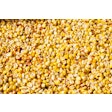
Feed & Grain takes a look back at 2007 and the massive corn crop’s impact on other feed grains. In Part One of this two-part series, we examine how the grain sorghum and wheat markets responded to the challenges and opportunities of last year and what they can look forward to in 2008.
By any measure, 2007 will likely be remembered as the year grain marketing changed forever.
Fueling the metamorphosis — both literally and figuratively — was a 90+ million acre corn crop which received its nearly 12 million acre boost over 2006, thanks in large part to a near frontier-days-style-land-grab demand for ethanol fuel stocks.
The resulting market volatility which ensued not only affected corn pricing with limit-busting price swings becoming an almost daily occurrence, but it is also changed the landscape for other grain markets significantly.
“Certainly in the case of wheat, corn’s impact was felt on several levels,” says Vince Peterson, vice president of Overseas Operations, U.S. Wheat Associates, Inc. “Some acreage was lost directly to corn but with substantially more acres of oilseeds planted in a few traditional wheat producing areas, such as the Northern Plains, wheat has been losing acres mainly to soybeans, canola and other crops.”
“All the while, these and other market events conspired to create a very peculiar marketplace reaction,” Peterson notes.
Creating the ‘perfect storm’
What Peterson refers to is a phenomenon that was unique to the wheat industry whereby the moment corn planted acreage figures looked to be reasonably final, it became a catalyst for the market to take on a price personality all its own.
In a four-and-a-half month span from June to mid-October, wheat prices skyrocketed. For example, September 2007 wheat futures settled at $8.40 in early September, nearly $1.00 above the previous record established in 1996, and as of this writing, prices were more than $1 over that mark.
Fundamental supply and demand was also fanning the flame of this red-hot marketplace with the revelation that the world was facing its second consecutive small wheat crop at a time when the United States was almost the only country with wheat to export. That has drawn down inventories to near-record low levels.
“Global wheat acreage had been on a steady decline over the last two decades and the world has consumed more wheat than it’s produced in nine of the last 15 years,” Peterson notes. “Increased average yields have helped keep pace with demand that is also changing.
“When a rapidly tightening supply meets steadily growing demand from more people with more money to spend on food, and at the same time wheat has to compete with corn, soybeans and other crops for acres, all the elements converge to create a wildly volatile marketplace with little regard to historical trending patterns or structure,” Peterson says.
Market madness mimicked in milo
While wheat was cutting its wide and wild swath through the marketplace, those who produce and market grain sorghum were experiencing a similar, if slightly less frantic ride of their own.
“While our pricing situation wasn’t as robust as wheat, we experienced a doubling of our commodity value from 2005 to today,” says Troy Skarke, a Texas grain sorghum producer, a director on the International Sorghum Markets Committee for the National Grain Sorghum Producers and a director on the U.S. Grains Council-Rest of the World (ROW) Markets. “The rapid growth of corn acreage and equally rapid disappearance of the 2007 crop from the trade arena had many buyers looking to grain sorghum to fill the void.”
According to USDA statistics, both production and acreage increased in 2007. Yield was forecast at 475 million bushels, up 71% from last year. Expected area for harvest as grain is forecast at 6.70 million acres, up 36% from 2006. Compared with last year, yield increases were expected in 10 of the 11 top producing states. In Kansas and Texas, the top two producing states, yields are expected to increase 16 bushels and 19 bushels from last year, respectively.
So with this statistical backdrop, you would think the countryside would be littered with storage bins chock-full of grain sorghum. Not even close.
Although 55% of the U.S. crop is earmarked for domestic use for feed, food and fuel production, a figure which stays relatively stable, it is the scramble over the remaining 45% dedicated to the export market which is making for an interesting marketplace. “About half of our exports go to Mexico for feed use and they’ve consistently been our No. 1 customer,” Skarke notes. “But for production and trade-related reasons, our exports to the EU just skyrocketed this year and we’re projecting an even heavier market presence in 2008.”
If you think Skarke may be guilty of a being too cocky in his confidence in the EU marketplace, keep these important marketing factors in mind: With the EU’s ban on accepting GMO corn products combined with the fact they already feed out half the wheat/barley they produce, grain sorghum becomes an even more attractive feedstock choice to producers there. With poor harvests further reducing an already depleted carryover supply, and the aforementioned price volatility of wheat, the EU came to the marketplace in a big way and brought their checkbooks with them.
To illustrate the EU’s desire for U.S. grain sorghum (see chart on pg. 54), according to Foreign Agricultural Service (FAS) statistics the EU has imported more than 1.4 million metric tonnes of sorghum in the first three months of the marketing year — which began September 1.
That number is 171 times the amount imported by the EU just six years ago! Spain accounts for more than 860,000 tonnes alone and is joined by the Netherlands, France, Ireland and Denmark as heavy purchasers.
Other factors driving the EU’s buying frenzy include the Euro’s purchasing power vs. the U.S. dollar — which makes buying U.S. sorghum more logical than paying a premium for hard-to-source EU-produced stocks — and another poor growing season for the U.S.’s chief competitor, Australia.
While sorghum and wheat industries are certainly sipping the long-awaited heady nectar of success right now, some serious concerns these boom markets have brought threaten to leave a sour aftertaste for some.
The pig in the python
For both Peterson and Skarke the trick to maintaining the enviable market position of U.S. wheat and grain sorghum growers could lie with the ability to continue serving existing export customers while reaching out to prospects.
“It would have been very difficult for wheat buyers to foresee how the dynamics of the corn market would add so much volatility to world wheat prices,” Peterson notes. “On top of that, global demand for ocean-going vessels and freight rates have also increased dramatically. Even rates for shorter hops to South American and Mexican ports have nearly doubled since last year from $39 to $63/metric tonne. So there is no doubt that these higher prices cause concern for buyers, especially in developing countries.
“For example, millers have to either absorb the higher prices or pass them on to their customers. That is why U.S. Wheat Associates representatives spend a lot of time helping buyers manage this situation,” Peterson says. “The need for that kind of service will continue as wheat prices should remain fairly high into next year, as global wheat stocks end the marketing year at near record-low levels.”
Skarke concurs on the point of customers needing to sharpen pencils and girding themselves for the new realities of grain pricing.
“Some of our long-standing customers are certainly concerned about our ability to supply their needs,” he points out. “However, we owe it to our producers and industry to develop new relationships and build value for our product.”
While the EU’s newfound interest is a sterling example of that theory put to practice, Skarke maintains the U.S. sorghum industry would be foolish to not do everything possible to meet the needs of its traditional customers like Mexico and Japan.
Both men agree that perhaps a potential stumbling block to fulfilling the new global opportunities for their U.S. growers may be right here at home if transporting the product from the interior elevators to the ports continues to be an issue.
“An overbooked and underserviced transportation system would limit our ability to supply our customers,” says Peterson. “Nobody wants to add demurrage fees on top of high prices and freight rates because you can’t deliver the crop to the port.”
True enough. Nothing could be more maddening than paying upward of $101/tonne for ocean freight rates and knowing that Panamax vessel is sitting in port with the meter running waiting for wheat to arrive at the port. Rising fuel costs and demand for vessels and container shipping have driven freight rates higher than ever before.
A look at 2008
Supply and logistics issues aside, when asked to offer a sneak preview of 2008, both Skarke and Peterson remain optimistic for continued success and growth for their respective industries.
Coming off a year where the wheat industry witnessed its first “fundamental change in pricing” since the early 80s, Peterson says fostering the U.S. wheat industry’s reputation as the world’s most reliable supplier of milling wheat should keep demand strong in 2008 and beyond.
“We’ve achieved a new, higher trading range for our product that is good for growers,” he explains. “We have one of the few truly open wheat markets in the world with no limits on access except supply and the industry is coming together to address that in the long-term.
“One way to help make wheat more competitive with other crops is through technology, which has helped other crops tremendously,” Peterson says. “Clearly, the world needs more wheat and we want to do what we can to ensure there is an ample supply well into the future.”
For Skarke success in 2008 is simple. Keep the newly found EU customer base engaged and committed to being a consistent buyer in 2008 and beyond.
Provisions of NAFTA will also allow Mexico to purchase more U.S. corn so opportunities to tap into markets in the Orient and North Africa offer great promise.
In large part, the 2007 corn crop has reshaped these two markets and created a host of new opportunities and challenges to watch for in 2008.
In our upcoming February/March issue, we take a similar look at the barley, soybean and other oilseeds markets, in addition to taking a look at the cottonseed markets.


















